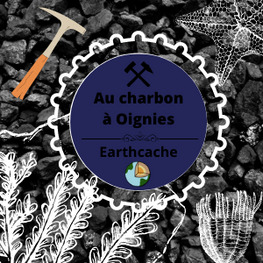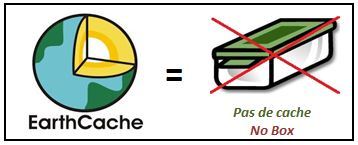

Cette cache a été posée à l'occasion du Mega évent "Au Charbon" à Oignies GC9XH0Z. Ce rassemblement a été voulu par les organisateurs comme un moment de convivalité entre passionés de Geocaching, de nature et de patrimoine. Notre volonté est de permettre à chaque profil de joueur de pouvoir pratiquer ce loisir comme il le souhaite et de partager avec d'autres des moments de rassemblement et de partage autour d'un site emblématique du bassin minier du Pas-de-Calais : Le carreau de fosse du 9-9bis de Oignies.
La "gaillette"
Cette Earth Cache a pour but de vous faire découvrir le charbon.
Horaires d'ouverture du 9-9bis: du lundi au vendredi de 9h à 12h et de 14h à 17h.
Pour répondre aux questions, vous aurez besoin d'une feuille de papier blanc.
La "gaillette", c'est quoi?
A part un terme souvent employé chez les Ch’tis, c’est un morceau de charbon, un bloc de combustible solide de couleur noir, calibré et de grosseur moyenne, qui servait à alimenter les feux.
Le nom vient du wallon gaille ("noix"), ce charbon se présentant en morceaux de la grosseur d'une noix.
En patois des mines du Nord et du Pas-de-Calais, une "gaillette" désigne donc un morceau de charbon à l’état brut. Le terme qualifiait également la femme ou la jeune fille chargée de trier le charbon.
En 1720, la première "gaillette" de charbon est extraite du puits n°1 de la fosse Jeanne Colard à Fresnes-sur-l’Escaut. La dernière a été remontée à Oignies le 21 décembre 1990. C'est à dire ici!
Comment se forme le charbon ?
Au Carbonifère (-360 à -300 millions d'années environ), dans les zones tropicales humides, de vastes et denses forêts de fougères arborescentes recouvrent les terres émergées - dont l'Europe, l'Asie et l'Amérique du Nord qui à cette époque sont sous les tropiques. Petit à petit, les débris de fougères et autres végétaux se déposent sur le sol, jusqu'à former une couche de plus en plus épaisse. Le niveau des mers fluctuant, cette couche se retrouve sous l'eau, les sédiments marins s'accumulent. Elle s'enfonce de plus en plus avec l'apport de nouveaux sédiments.

Avec l'augmentation de la pression et de la température, les végétaux morts se transforment. Ils libèrent de l'oxygène (O2), de l’hydrogène (H2), de l’azote (N2). Le taux de carbone (C) augmente mécaniquement.

Durant ces différents stades de sédimentation et d’enfouissement, la teneur en carbone du charbon évolue avec la profondeur:
- la tourbe (50 à 55 % de carbone)
- le lignite (55 à 75 % de carbone)
- la houille (75 à 90 % de carbone)
- l’anthracite (plus de 90 % de carbone)
La tourbe
La tourbe est plastique et fibreuse, de couleur blonde, brune ou noire. Son éclat est terne, les fibres végétales sont très visibles et détachables facilement.

Le lignite
Le lignite est de couleur sombre, ne présente quasiment plus de fibres comme la tourbe. Son éclat est terne. Sa trace est brune, relativement claire.

La houille
La houille est de couleur noirâtre, elle est compacte et présente un éclat plus ou moins brillant. Le toucher est gras. Sa trace est marron très foncé.

L'anthracite
L'anthracite est une variété de charbon, grise à noirâtre et brillante, riche en carbone. Le toucher est gras, sa trace est grise très foncée, presque noire.

Sources
Comment valider cette Earth Cache
Petit rappel concernant les "Earth Caches": il n'y a pas de contenant à rechercher, ni de logbook. Il suffit de se rendre sur les lieux, de répondre aux questions ci-dessous. Vous pouvez loger en "Found it" et envoyez-moi vos propositions de réponses, soit via mon profil, soit via la messagerie geocaching.com (Message Center), et je vous contacterai en cas de problème.

Localisation
Une fois entré dans la salle, dirigez vous vers l'escalier de l'auditorium. A proximité se trouve un wagonnet (une berline) empli de blocs.

Questions
- 1a: Où et quand a été remontée la dernière "gaillette" dans le bassin du Nord Pas-de-Calais?
- 1b: A quelle période géologique se sont formés les dépôts de charbon de la région?
- 1c: Lorsque la pression et la température augmentent, que se passe-t'il?
- 2a: Prenez un morceau de roche contenu dans le wagonnet. Au toucher, comment est-il?
- 2b: Quels sont sa couleur et son éclat?
- 2c: Tracez le G de Geocaching sur une feuille de papier blanc. De quelle couleur est la trace?
- 2d: En vous référant à la description des roches, de quoi s'agit-il?
- 3: Une photo de vous ou d'un objet vous représentant, est obligatoire pour valider cette Earth Cache.
Merci par avance de ne pas poster de spoiler dans vos logs!
Bon Geocaching!


This cache was placed during the Mega vent "Au Charbon" in Oignies GC9XH0Z. This gathering was wanted by the organizers as a moment of conviviality between enthusiasts of geocaching, nature and heritage. The desire is to allow each profile of player to be able to practice this leisure as he wishes and to share with others moments of gathering and sharing around an emblematic site of the mining basin of Pas-de-Calais: the pit tile of 9-9bis of Oignies.
The "gaillette"
This Earth Cache aims to make you discover coal.
Opening hours: Monday to Friday from 9am to 12pm and from 2pm to 5pm.
To answer questions, you will need a blank sheet of paper.
What is the "gaillette"?
Apart from a term often used by the Ch'tis, it is a piece of coal, a block of solid fuel, black in colour, calibrated and of medium size, which was used to fuel fires.
The name comes from the Walloon word "gaille" ("walnut"), as this coal is made up of pieces the size of a walnut.
In the dialect of the mines of the Nord and Pas-de-Calais, a "gaillette" therefore refers to a piece of coal in its raw state. The term was also used to describe the woman or girl in charge of sorting the coal.
In 1720, the first "gaillette" of coal was extracted from shaft no. 1 of the Jeanne Colard pit at Fresnes-sur-l'Escaut. The last one was hauled up in Oignies on 21 December 1990. That is to say here!
How is coal formed?
In the Carboniferous period (around 360 to 300 million years ago), in the humid tropics, vast and dense forests of tree ferns covered the land - including Europe, Asia and North America, which at that time were in the tropics. Gradually, the debris of ferns and other plants settled on the ground, until it formed a thicker and thicker layer. As the sea level fluctuates, this layer is under water and the marine sediments accumulate. The layer sinks deeper and deeper as new sediment is added.

With the increase in pressure and temperature, the dead plants are transformed. They release oxygen (O2), hydrogen (H2) and nitrogen (N2). The carbon (C) content increases mechanically.

During these different stages of sedimentation and burial, the carbon content of the coal changes with depth:
- peat (50-55% carbon)
- lignite (55 to 75% carbon)
- hard coal (75-90% carbon)
- anthracite (over 90% carbon)
Peat
Peat is plastic and fibrous, blond, brown or black in colour. It has a dull sheen, the plant fibres are very visible and easily detachable.

Lignite
Lignite is dark in colour and has hardly any fibres like peat. Its luster is dull. Its trace is brown, relatively light.

Hard coal
The coal is blackish in colour, compact and has a more or less brilliant sheen. It is greasy to the touch. Its trace is very dark brown.

Anthracite
Anthracite is a grey to blackish, shiny, carbon-rich variety of coal. It is greasy to the touch and has a very dark grey, almost black, streak.

Sources
How to validate this Earth Cache
A reminder about the "Earth Caches": there is no container to look for, nor a logbook. You just have to go to the place and answer the questions below. You can log in "Found it" and send me your suggestions for answers, either via my profile, or via the geocaching.com message center, and I will contact you if there is a problem.

Location
Once you have entered the room, head for the auditorium stairs. Nearby is a wagon filled with blocks.

Questions
- 1a: When and where was the last 'gaillette' mined in the Nord Pas de Calais basin?
- 1b: At what geological period were the coal deposits in the region formed?
- 1c: When pressure and temperature increase, what happens?
- 2a: Take a piece of rock from the wagon. What does it feel like?
- 2b: What is its colour and luster?
- 2c: Draw the Geocaching G on a piece of white paper. What colour is the trace?
- 2d: Referring to the description of the rocks, what is it?
- 3: A photo of you or an object representing you is mandatory to validate this Earth Cache.
Thank you in advance for not posting spoilers in your logs!
Happy Geocaching!
